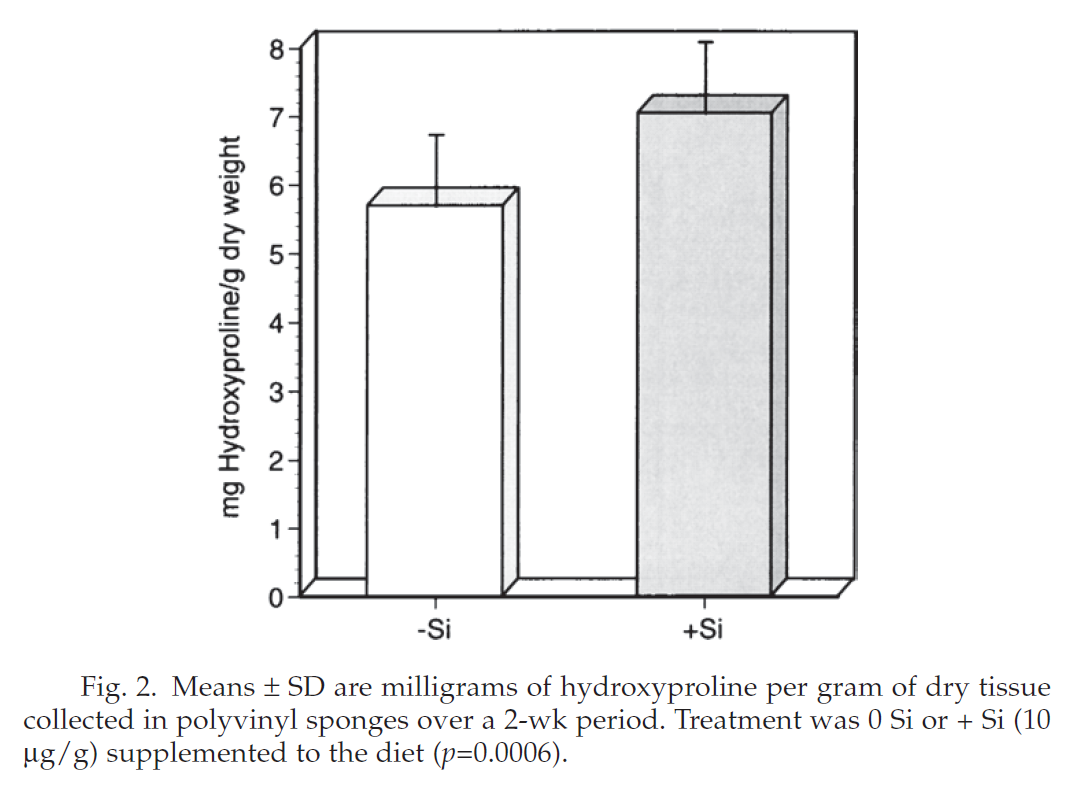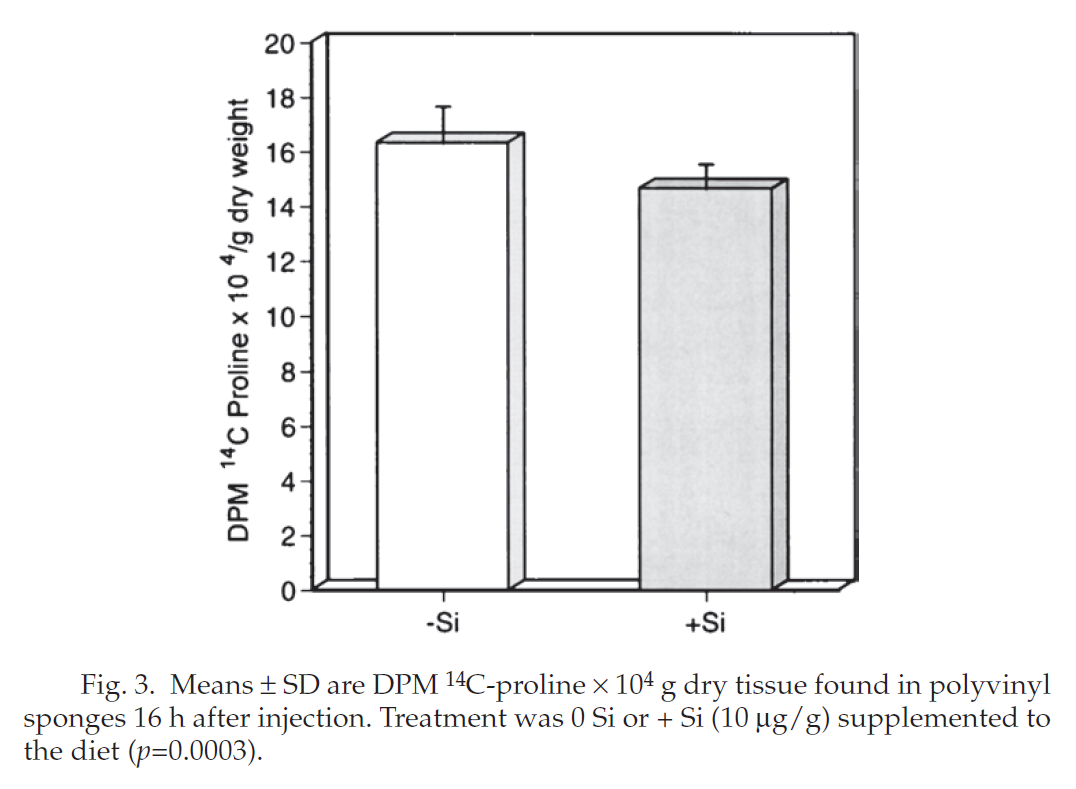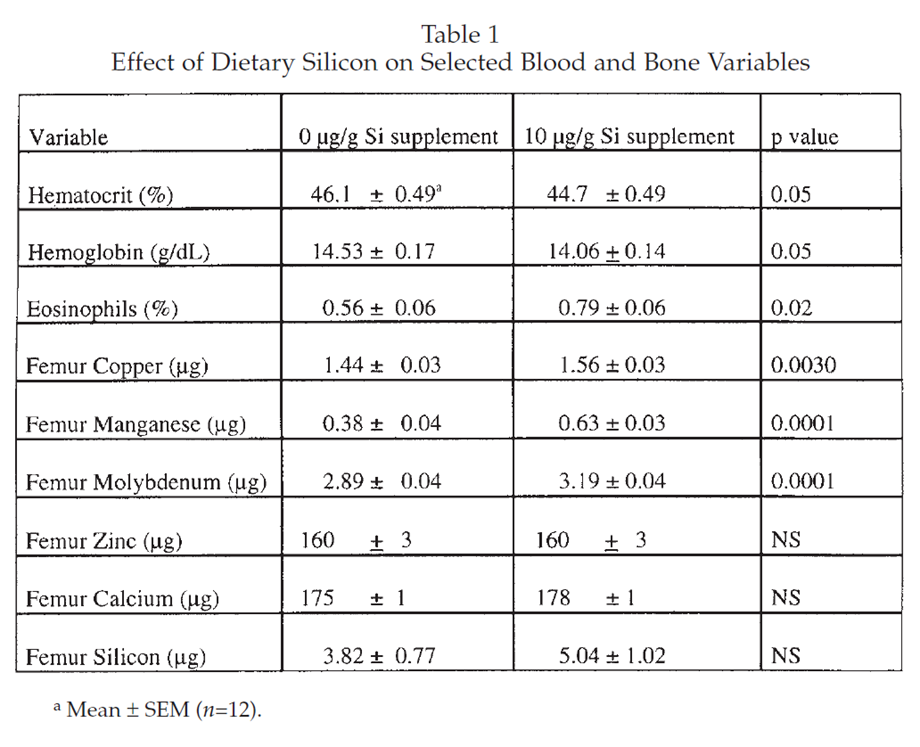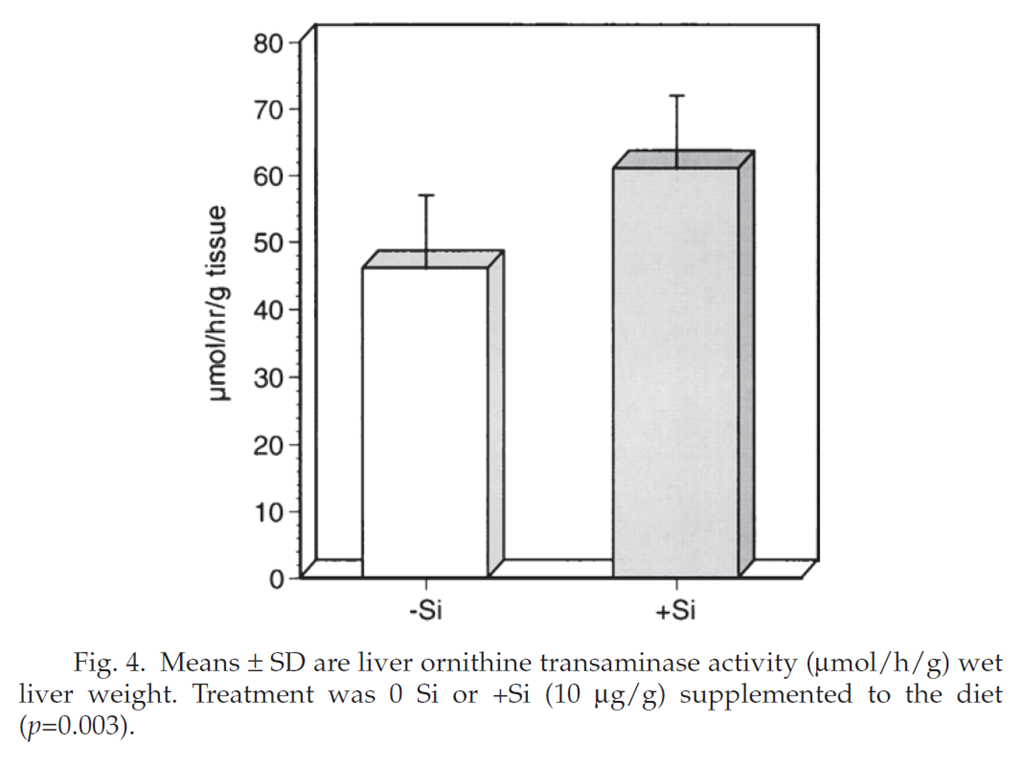"Silicon deprivation decreases collagen formation in wounds and bone, and ornithine transaminase enzyme activity in liver"
-
"Signs of silicon (Si) deficiency were described for chickens and rats (1–3), which led to the suggestion that silicon is an essential element (4). Most of the reported signs of silicon deficiency indicated an aberrant metabolism of connective tissue and bone. Abnormalities in articular cartilage and connective tissue were produced in chicks fed silicon-deficient diets (5). Subsequent experiments demonstrated that silicon-deficient chicks had structural abnormalities and depressed collagen content of the frontal bones, long-bone abnormalities characterized by small, poorly formed joints, and defective endochondral bone growth (6). These findings led Carlisle (7) to question, as early as 1975, whether silicon deficiency might also impact wound healing."
"Two experiments were conducted to ascertain the effect of silicon deprivation on collagen variables in addition to the collagen content in bone."
"In experiment 1, the effect of adequate or inadequate dietary silicon on wound healing was assessed by the incorporation of proline and accumulation of collagen in sponges surgically implanted in rats."
"[..]the total amount of hydroxyproline was significantly lower (p<0.005) in sponges taken from silicon-deficient animals (5.70 ± 1.04 mg) than silicon-adequate (7.05 ± 1.05 mg) rats (see Fig. 2). The disintegrations per minute of 14C-proline expressed per gram of dry tissue were significantly higher in extracts from sponges from silicon-deficient than silicon-adequate rats (see Fig. 3)."


"For experiment 2, the objective was to determine whether inadequate silicon would alter the activity of ornithine aminotransferase, an enzyme needed to form proline, which is a substrate for collagen formation. Blood variables and bone mineral composition were also assessed to substantiate the achievement of a silicon deprivation."
"[..]hematocrit (46.1% vs 44.7%, p=0.05) and hemoglobin (14.53 vs 14.06 g/dL, p=0.04) were higher in silicon-deprived than silicon-adequate rats (see Table 1). The silicon-inadequate animals also exhibited significantly less eosinophils expressed as a percentage of total white blood cells than animals fed adequate silicon (0.56% vs 0.78%, p=0.02). The activity of ornithine aminotransferase was lower in liver of silicon-deprived than silicon-adequate rats—50.7 versus 65.1 μmol/h/g tissue (see Fig. 4). Table 1 also shows that the concentrations of copper, manganese, and molybdenum in the femur were depressed by silicon deprivation. The concentration of silicon in bone was also in the expected direction when dietary silicon was inadequate. Dietary silicon did not affect femur calcium concentration."


"Based on the femur mineral composition data in Table 1, which are similar to data obtained in previous silicon-deprivation studies, rats fed the low-silicon diet in the present experiment were silicon deficient. Thus, the findings in the present study show that silicon deprivation decreases the formation of collagen associated with wound healing, an enzyme involved in collagen formation, and in eosinophils, that play an important role in wound healing. The depression in each of these variables could increase the length of time for wounds to heal, and the changes in sponge variables confirm this, that is, the decrease in sponge (wound) collagen and the increase incorporation of 14C-proline into sponges placed in silicon-deficient rats most likely reflect delayed collagen formation in the wound healing process. In other words, higher hydroxyproline (collagen) content with a lower 14C-proline content (indication of an increased conversion to hydroxyproline) suggests that collagen formation or incorporation in the sponge was faster and greater in silicon-adequate rats than in the silicon-deficient rats. Moreover, this effect of silicon on collagen formation was induced by physiological, not pharmacological, amounts of silicon. The 10-μg Si/g diet used in the present study is lower than we found in rat diet composed of natural ingredients."
"The successful healing of wounds requires the local synthesis of significant amounts of collagen. The amino acids that are the immediate precursors for collagen synthesis within wounds have not been specifically identified, but are likely to include the free amino acids contained in the extracellular wound fluid. Albina et al. (15) showed that this fluid is rich in proline and its metabolic precursors—ornithine, glutamate, and glutamine—and that ornithine contributes to the synthesis of protein-bound proline in wounds by increasing the local extracellular pool of free proline. The decreased activity of liver ornithine aminotransferase, which converts ornithine to proline, in silicon-deficient animals indicates that silicon adequacy is also important for the activity of this enzyme in peripheral tissues, where it apparently is critical in promoting wound healing."
"Song et al. (16) suggested that eosinophils play an important role in the organizational aspects of wound healing. Human eosinophils stimulate matrix production in dermal fibroblasts (17). Eosinophils also deliver cytokines involved in wound-healing process. Thus, our eosinophil findings are consistent with silicon being important for wound-healing. Moreover, the dispersion of the collagenous fibers in areas around wounds that occurs before the rise in eosinophil numbers apparently can be affected by the sulfated glycosaminoglycans in the wound area (18). In addition to affecting eosinophil numbers, silicon nutriture can affect the glycosaminoglycan content of tissue. This was demonstrated by Carlisle (19), who found that silicon deprivation in chicks depressed the glycosaminoglycan content in connective tissue. Silicon also is consistently found as a component of some sulfated glycosaminoglycans."
"Although not determined in the present study, a finding in another study by us (20) suggests that silicon could exert an influence on wound healing through still another mechanism. Hoffman et al. (21) reported findings indicating that T-lymphocytes at the wound site are crucial for the healing process. We found that when normal amounts of arginine were fed, silicon deprivation decreased the proliferation of splenic lymphocytes stimulated by concanavalin A (20). This effect indicates that silicon is needed for optimal proliferation of T-lymphocytes in the wound-healing process."
"The present study also supports the hypothesis that silicon is important in bone formation through an effect on collagen formation or organic matrix composition. The finding that silicon deprivation decreased the collagen content in bone of 3-wk-old rats is consistent with results obtained in other studies. For example, Carlisle (6) reported that tibiae of silicon-deficient chicks had depressed contents of articular cartilage, water, hexosamine, and collagen. We found decreased bone collagen in rats fed a silicon-deficient diet for 9 wk (22). We have consistently found that silicon deficiency decreases the copper concentration in bone (9); this was also found in the present study. Copper is needed for the crosslinking of collagen in bone. Thus, through an effect on copper, silicon might be affecting organic matrix composition or function and, ultimately, bone formation. Further support for silicon being important in collagen formation in bone is the finding of Carlisle (23) that maximal prolyl hydroxylase activity in cultured chick embryo frontal bones was dependent on silicon."
-
-
Interesting find -- thank you -- especially in conjunction with the other Si benefits we've considered and discussions on which forms of Si are bioavailable and which are not, such as in Oligomeric but not monomeric silica prevents aluminum absorption in humans - PubMed
-
The authors in the OP paper do not discuss their choice of Si but directly take the polymeric form, sodium metasilicate, which is less bioavailable according to the paper mentioned in my bullet item above. However, the rate of bioavailability seems to depend on the dilution of the concentrated silica solutions, in which case "the formation of monomeric silica is likely".
-
Good to know also that "The physiological amounts of dietary silicon, compared to inadequate silicon, in the present experiment increased the activity of an enzyme necessary for collagen formation, enhanced collagen deposition" and that these amounts apparently met by commercial rat diet.
-
Side note: Authors also speculate that to see an effect on Ca levels a longer supplementation might be needed:
This is in contrast to findings obtained in other experiments by us (9). The difference, however, probably was related to the age of the animals or the length of time the animals were maintained on the silicon-deficient diet. In previous experiments, weanling rats were fed the silicon-deficient diet for 8 or 9 wk before bones were obtained for analysis; in the present experiment, weanling rats were fed the silicon-deficient diets for only 3 wk." -
- Interesting that the effect on collagen is seen much earlier than that on calcium.
-
-
This is why I make tzatziki every so often. Cucumber is a good source of silicon and is easy on my digestion.
-
Hi, @Lejeboca!
If the silicon form is meant to complex with aluminium and stay in the gut for excretion, it won't serve for repletion.
-
@Amazoniac ,
Good catch. Thanks for the correction. I've edited my post (the 1st two bullets).
I am a bit puzzled though why the authors in the OP study didn't use monomeric Si if they were looking for Si bioavailability. Perhaps, the concentrations of the Si polymer that they fed to the rats were low enough that they formed monomers... -
 D DavidPS referenced this topic on
D DavidPS referenced this topic on